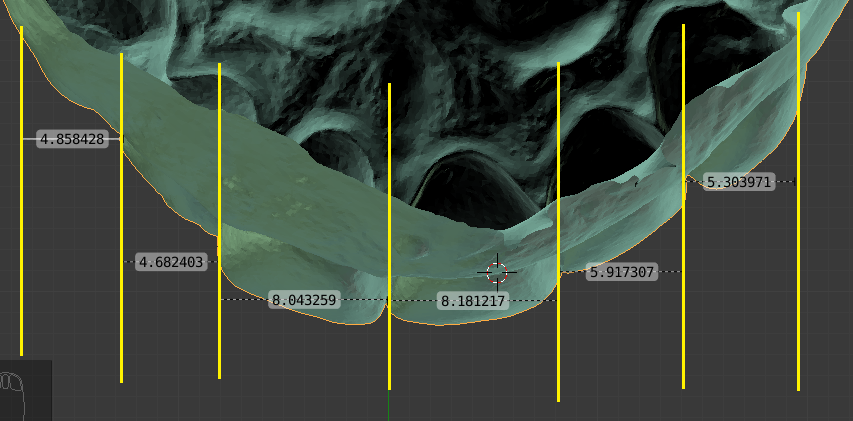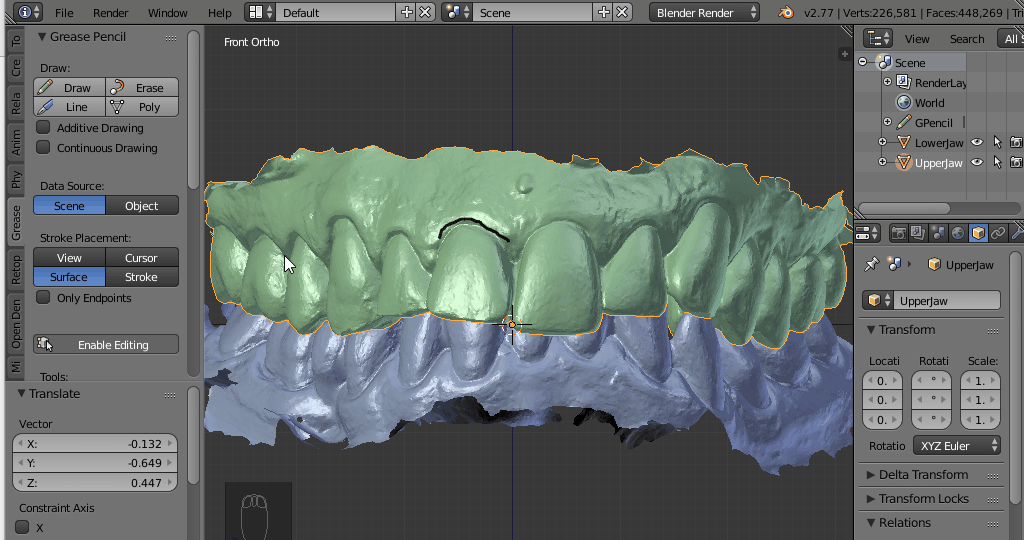-
Notifications
You must be signed in to change notification settings - Fork 44
Case 1 Analysis and Measurement
In this case, we will use extensively the ruler/protractor and grease pencil to make a series of measurements on several dental casts. These skills are useful for diagnosis and treatment planning, as well as communication between lab/clinician or between clinicians.
- Import the maxillary and mandibular *.stl file from the Differential Wear directory
- Rename them UpperJaw and LowerJaw
- Add a nice material if you like
- With both models selected, rotate and translate to align the occlusal plane, sagital and frontal view with the Blender world axes.
- With both object's selected, press 'Ctrl + A' and 'Apply Location'. Then 'Ctrl + A' and 'Apply Rotation'

- Press 'T' to open the Tools Panel and navigate to the Grease Pencil tab
- Click on the "Ruler Protractor" button.
- Start by 'Ctrl + LeftClick' and drag while holding 'Ctrl' to measure from embrasure to embrasure. Holding 'Ctrl' will keep the measurement snapped to the surface.
- If you rotate from a different view, you can 'LeftClick' and drag to move the measurement away from the surface to more accurately measure to the center of contacts.
- Press 'Enter' to save the measurments. The next time you enter the "Ruler/Protractor" tool, your measurements will still be there
- A short video

We will take advantage of Orthographic views, and not snapping the measurement tool to measure the width of the teeth in the frontal view. This is useful for example in "Golden Ratio" aesthetic planning.
- Ensure that you are in "Orthographic View" by pressing 'Numpad 5'
- Then view the models from the frotnal view by pressing 'Numpad 1'
- "Ctrl + LeftMouse' on the embrasure, while holding 'LeftMouse,' release the 'Ctrl' key and drag. This will snap the 1st end of the measurement tool to the surface of the model, but then move the 2nd end of the caliper perpendicular to your view.
- video

(Optional) Bolton's Analysis Video
This is such an interesting case not only because of the different heights of the teeth, but also because of the different extractions/missing teeth between the maxilla and the mandible. For this exercise, we will use the "Copy" function of the protractor to record the measurements into a .text document. We will then format that text document as a 'python' script to do our Bolton calculations.
- Measure and record the length of the maxillary teeth from 1st molar to 1st molar. This is accomplished bes by the following
- Complete all measurements in the measure tool. Then press 'Enter' to store them
- Split the screen, and convert the 2nd screen to a text editor
- Create a new text datablock
- Create a list object to store your measurements
- 'LeftClick' on a measurement, 'Ctrl + C', then move the mouse over the text editor and 'Ctrl + V'. Then add a comma and a space. Repeat
- Repeat for the mandibular teeth
- save this file, we will use it later for a programming exercise!
This part of the exercise will focus more heavily on the "Grease Pencil" which is a tool for drawing and annotating items in the 3D View.
- Decide whether annotations will be related to a single model, or to the entire scene. There are advantages to either. A rule of thumb is whether the information is needed when more than one object might be selected.

-
Drawing on Model Surface (good for landmarks and features)

-
Drawing defined by cursor (good for incisal edges and planes)

-
Polygon Drawing (good for smile line)

-
Endpoints Only Snapping (good for root angulations)

-
Screen Drawing (good for visual references)

-
Combine the skills/concepts above
Use the grease pencil and ruler to help develop your orthodontic and prosthetic plan to maximize the result for this case. How much do we need to move teeth versus restore teeth?


- Single Unit Crown
- 3 Unit Bridge
- Single Implant Guide
- Arch Planning
- Die and Model Repair
- Cutbacks
- Implant Temporary